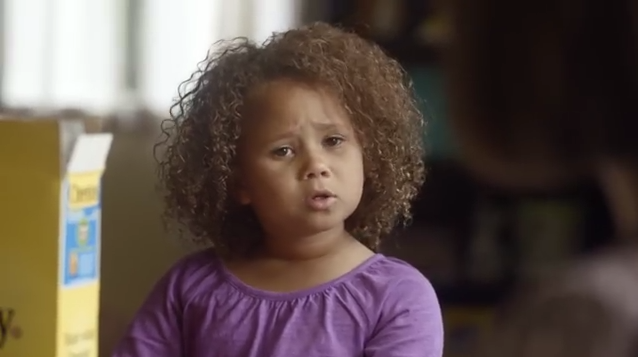Last year, the cereal brand Cheerios released a commercial that featured an interracial couple and their biracial daughter. The racist backlash against seeing a black man with a white woman was so severe that Cheerios had to disable comments on its YouTube account. During the Super Bowl this year, the brand double-downed on its efforts to be reflective of a diverse nation and released a second commercial featuring the same family. In the new ad, the mother is pregnant with the couple’s second child. This commercial was marked with far less backlash.
This set of advertisements reflects the increase of interracial marriages in America, but Cheerios is not the first brand to have such a couple in its commercials. Many brands over the last several years have had ads that feature black women with white men, and yet they didn’t cause anywhere near the level of controversy as the Cheerios ads. Why does seeing a black man with a white woman stir up a hornet’s nest of racism, but not the reverse? America’s history is rich with fear of black male sexuality, as evidenced in cultural markers such as the silent film Birth of a Nation and the brutal death of Emmett Till, a teenager accused of whistling at a white woman. However, the interracial pairing of a black woman with a white man doesn’t seem to raise the same kind of alarms. Perhaps it’s because black women dating white men has been promoted as panacea for all the alleged problems black women face when it comes to dating.
In 2009, the dating website OkCupid released data suggesting that black women get the fewest responses, even from black men. The data launched a thousand blog posts and articles, some urging black women to date outside of their race in order to find more mates. The idea is that the more educated or the more successful black women become, the fewer opportunities they have to date black men, and therefore, they should expand their dating pool. It’s another more analytical, less stereotypical way of saying black men aren’t worthy enough to date so turn to someone else.
In film and television, including commercials, there is an increasing number of black women-white men couples that air with little debate. People may notice but there’s nothing on the level of the Cheerios fiasco. Although the popular television show Scandal raises some eyebrows over its main couple — the interracial pairing of Olivia Pope (Kerry Washington) and President Fitzgerald Grant (Tony Goldwyn) — it’s produced more finger-wagging because of the characters’ acts of infidelity, not because of their races.
The cleaning brand Swiffer recently released a commercial that features the Rukavina family, a white man with his black wife and their biracial child. The husband has lost his forearm to cancer. The ad has been recognized for its inclusion of a person with a physical challenge as well as the racial dynamics of the family. It hasn’t received negative attention of any note, perhaps because people are less willing to launch hate at an amputee. It’s interesting to note that with the first Cheerios ad, the black husband and white wife were never in the same room together, and it still was still alarming. Three years ago, Sealy Mattresses released a commercial that features at least two white men in interracial couples in a clearly sexual situation, and there was barely any recognition. The Philadelphia Cream Cheese commercial showing a white man and black woman touching and kissing as they prepare dinner together caused barely a blip.
Even after the Swiffer commercial, or the Tide ad which features an Asian woman and black man as a couple, the second Cheerios installment still caused controversy. In an attempt to share the ad, the MSNBC twitter account posted: “Maybe the rightwing will hate it, but everyone else will go awww: the adorable new #Cheerios ad w/ biracial family.” Republican outrage followed. Many conservatives responded with the hashtag #myrightwingbiracialfamily, posting pictures of their multiracial families to combat stereotypes, a striking contrast to a poll from a few years ago that indicated a large number of southern Republicans still opposed interracial marriage. MSNBC president Phil Griffin issued an apology, which Republican National Committee Chairman Reince Priebus accepted.
The American public seems more willing to accept (or ignore) seeing a black woman with a white man than a black man with a white woman. According to reports, black men have a higher rate of interracial marriage than black women, which means it’s more common, and yet it also launches more racist backlash. While bigots focus on tearing down the significance of the family in the Cheerios commercials, advertisements featuring white men with nonwhite women are overlooked. Commercials with white men coupled with black women don’t cause nearly as much disagreement as the inverse. Maybe it’s because white men are seen as improving a black woman’s life, saving her from black men who are more interested in dating white women, if various statistics are to be believed.
Regardless, none of these interracial commercials should be targeted for hate. In fact, commercials still have a long way to go to be more reflective of the country’s diverse households.
Nichole Perkins is a freelance writer, based in her hometown of Nashville, Tennessee.






